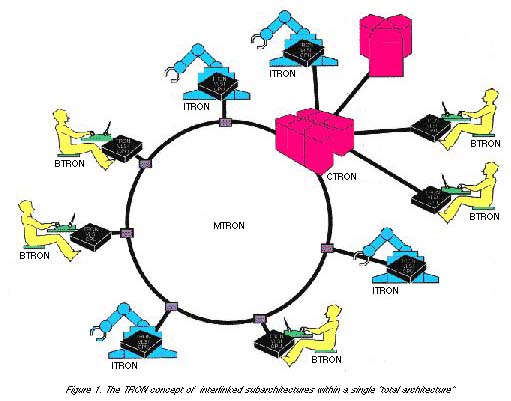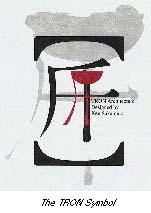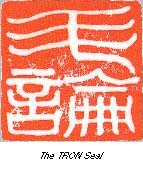

TRON is an acronym that stands for "The Real-time Operating system Nucleus," an expression that's a little difficult to understand unless you have a background in computer science, so let's break this acronym down into three pieces and explain it so that anyone can understand it.
First, there is the problem of what the term "real time" means. To the lay person, this is an absurd expression, because all time is real time, isn't it? Is there such a thing as unreal time? Well, in a way there is, although it is more properly referred to as "system time," that is, the amount of time it takes the computer system to process a task. When the amount of system time it takes a computer system to process a task is short enough to allow the computer system to respond in time to an event in the real world, then that computer system is said to be a "real-time system." In other words, it's a system that is capable of processing in "real-world time." (Those who would like detailed information on real-time systems should refer to the following FAQ.)
In order to better understand this, consider today's personal computer systems. They don't necessarily process tasks in time to meet your needs, which is why the little wrist watch icon or hourglass icon keeps appearing on the screen of your computer for longer and longer periods of time--and that's in spite of the fact that microprocessors have gotten faster and main memories have grown considerably in size. So what's the reason for that? Well, for starters, the operating systems we use today are gargantuan in size compared to those of the early personal computers. Another reason is that the application software we use today has become bloated due to the addition of ever more features. And finally there is the fact that the latest generations of personal computers have been designed to process multiple tasks simultaneously. Thus it's actually possible to "overtask" one of today's personal computers, which can result in the entire system locking for 10 or 15 minutes. That can hardly be described as "real-time performance."
Second, there is the term "operating system," which most people have heard of, but may not be sure of either its meaning or importance. In a computer system, software is built hierarchically, that is to say, layer upon layer. At the bottom of this hierarchy is the operating system, which is a group of small programs that provide the core functionalities for the higher layers. Thus the better the bottom layers are designed the easier it is to provide advanced functions to the higher layers. Moreover, if the bottom layers are designed from the start for real-time processing, then the upper layers can also be designed to effect processing in real time.
The biggest problem with today's personal computer operating systems is that the bottom layers weren't designed for running multiple tasks, and they weren't designed for processing in real time. The results of this are instability that leads to frequent system crashes and slow processing. But this state of affairs shouldn't really be surprising, since the bottom layers of today's personal computer operating systems were designed to run on tiny hardware platforms and were rushed to completion as a result of market forces. (Yes, market forces produce both good and bad results!)
Now the companies that developed the original personal computer operating systems are trying to update them so that they are more stable and offer high-performance multitasking, but that's easier said than done. In the case of Apple Computer Inc., for example, the development to upgrade the company's Macintosh operating system was so problem plagued that Apple purchased NeXT Software Inc. to gain access NeXT''s NEXTSTEP operating system, which it plans to use as the foundation for its new flagship operating system--a merger of Macintosh and NEXTSTEP--to be marketed under the name "Rhapsody" in 1998. NEXTSTEP is a modern operating system based on a "microkernel," the Mach microkernel developed at Carnegie-Mellon University to be exact, which brings us to the third term in the TRON acronym, "nucleus." (Those who would like to view a list of links to operating system Web pages should click here.)
A "kernel," which is also referred to as an "executive" or a "nucleus," provides the core functionality that the higher-level parts of a modern operating system are built upon and rely upon to function properly. A modern kernel handles such critical functions as the timing and switching of tasks (the faster the switching, the better the real-time performance), the allocation and management of memory (traditional personal computer operating systems have been weak at this, which is why they frequently crash), and communication among tasks (for example, transferring the output of one task to another task for input).
Well then, what makes TRON so special if there are already other kernels out there? The answer is two things.
First, TRON is not a collection of computer code that a systems engineer compiles and runs on a particular processor. Rather, it is a set of "interfaces and design guidelines" (in other words, a set of software design specifications) for creating the computer code that will become the kernel. Although these interfaces and design guidelines are copyrighted by the TRON Association, they are available for use by software developers anywhere in the world without charge. Thus the computer architecture based on TRON, the TRON Architecture, is an "open architecture" that welcomes cloning and interoperability.
Second, unlike other modern kernels developed to date, TRON was proposed to serve as a common software core for all the various types of computer systems used throughout human society and human living spaces. Needless to say, since a single real-time kernel obviously could not run across everything from an 8-bit single-chip microcontroller to a mainframe computer central processing unit, there are many versions of this software core that have been defined to meet the needs of the various systems. When taken together, these various versions of TRON, which are all compatible with each other, form the basis for the world's first "total computer architecture." Moreover, since TRON has been designed through a top-down approach with the needs of high-speed networking in mind, TRON also forms the basis of a highly efficient "real-time" network architecture [Fig. 1].

The TRON Architecture is divided into four main subarchitectures. These are:
Industrial TRON (ITRON)
Business TRON (BTRON)
Central and Communications TRON (CTRON)
Macro TRON (MTRON)
Since the first three of these subarchitectures are used across a wide range of computer systems, there are multiple specifications with each subarchitecture. For example, in the case of ITRON, there are specifications for 8-bit, 16-bit, and 32-bit MPUs.
In addition to the above four main subarchitectures, there is also an open microprocessor architecture called TRON VLSI CPU architecture for designing 32-, 48-, and 64-bit MPUs. MPUs based on this architecture have functions for supporting real-time multitask processing in TRON-based networks.


The TRON Symbol in red on the left is based on the Chinese character behind it, which is pronounced 'to' in Japanese and means a '[Chinese] peck measure' or 'dipper', in other words a large standard vessel for measuring volume or capacity. Since the TRON Project is a large standardization movement that intends to increase the volume of interactions between computers, TRON Project Leader Ken Sakamura felt it would be appropriate to use this Chinese character as the basis for the TRON Project Symbol. The TRON Seal on the right, which Prof. Sakamura had made in China during one of his many trips there to evangelize the TRON Project, is based on the ancient Chinese seal characters for 'tou' and 'lun', 'to' and 'ron' in Japanese, which is how someone from China would pronounce TRON in Chinese. Seals of this type have been used for thousands of years in East Asia for purposes of authentication.